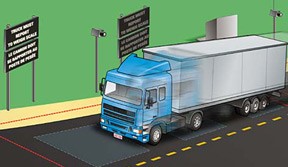
Four Weigh-in-Motion (WIM) systems on the Trans-Canada Highway (Routes 1 and 2) are increasing efficiency for the trucking industry by reducing the number of weight compliant vehicles required to exit the highway and report to the scales. They are also reducing vehicle emissions and collision risks at access points.
These systems are located eastbound on Route 2 at Longs Creek and westbound on Route 2 at Deerwood and Salisbury and eastbound on Route 1 near Waweig. These systems are jointly funded by the Governments of Canada and New Brunswick.
An evaluation of the Longs Creek site indicates that approximately $600,000 per year is saved by the commercial trucking industry as the number of trucks required to report to the scales has been reduced by approximately 55 per cent.
Trucks approaching these systems are now required to use the right hand driving lane. Loops embedded in the roadway track the movement of each vehicle through the system. The WIM system registers a vehicle’s weight and axle configuration, as well as other information, as it travels over the WIM scale at highway speed.
